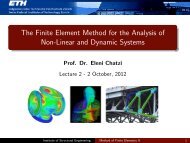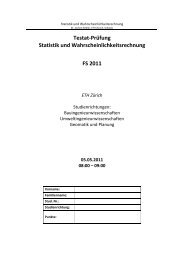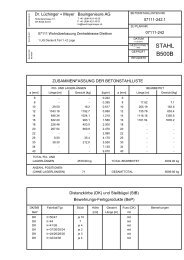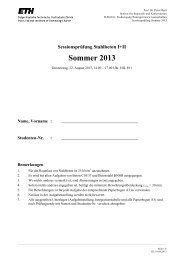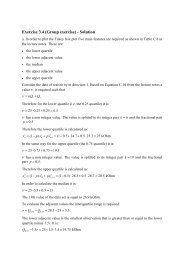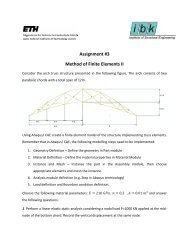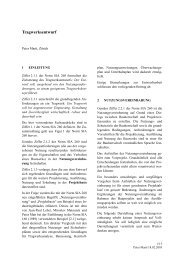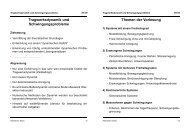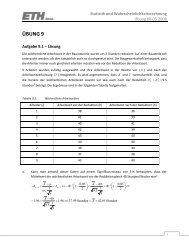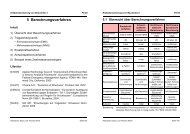A New Program for the Design of Cable-Stayed Bridges Summary 1 ...
A New Program for the Design of Cable-Stayed Bridges Summary 1 ...
A New Program for the Design of Cable-Stayed Bridges Summary 1 ...
Create successful ePaper yourself
Turn your PDF publications into a flip-book with our unique Google optimized e-Paper software.
<strong>for</strong>ces but not to bond producing discontinuities in <strong>the</strong> total strain (<strong>the</strong> elastic and <strong>the</strong> initial strain<br />
summed toge<strong>the</strong>r) because in <strong>the</strong> finite element model <strong>the</strong> element is “<strong>for</strong>ced” in its un-displaced<br />
shape <strong>for</strong> <strong>the</strong> <strong>for</strong>mulation <strong>of</strong> global equilibrium conditions <strong>the</strong> elastic strain must compensate any<br />
initial strain.<br />
5. Conditional loads<br />
Fig. 7 Snapshot <strong>of</strong> <strong>the</strong> program BRIDE showing <strong>the</strong><br />
deflected shape <strong>of</strong> a model in which <strong>the</strong> cables have not<br />
been post-tensioned<br />
The so-called conditional loads<br />
represent <strong>the</strong> post-tensioning <strong>of</strong> <strong>the</strong><br />
cable-stays and <strong>the</strong> pre-camber <strong>of</strong> mast<br />
and deck segments. Their intensities<br />
are automatically computed by <strong>the</strong><br />
program BRIDE.<br />
Both conditional loads and regular<br />
loads are model objects to be inserted<br />
in <strong>the</strong> chronological objects list (see<br />
section 6). The only differences is that<br />
in regular loads <strong>the</strong> load intensity is<br />
explicitly defined while in conditional<br />
loads it is defined through a condition<br />
to be fulfilled, and that conditional<br />
loads always belong to <strong>the</strong> standard<br />
load case load_history (see section 7).<br />
Their needed intensities are found<br />
automatically by <strong>the</strong> program BRIDE<br />
by fulfilling appropriate conditions<br />
specified by <strong>the</strong> program user (e.g.<br />
"post-tension a cable with such a <strong>for</strong>ce<br />
that its anchoring point on <strong>the</strong> deck<br />
has no vertical displacement in <strong>the</strong> last<br />
construction stage, taking into account<br />
<strong>the</strong> dead load and all o<strong>the</strong>r conditional<br />
loads", see figures 7 and 8).<br />
Fig. 8 Snapshot <strong>of</strong> <strong>the</strong> program BRIDE showing <strong>the</strong><br />
deflected shape <strong>of</strong> <strong>the</strong> same model as in figure 8 but<br />
post-tensioned with automatically found intensities<br />
6. Chronological objects list: a full description <strong>of</strong> <strong>the</strong> erection process<br />
After some attempts it became clear that <strong>the</strong> most convenient way to specify <strong>the</strong> evolving model <strong>of</strong><br />
a cable-stayed bridge during construction is a list <strong>of</strong> all model's objects (nodes, elements, supports,<br />
<strong>for</strong>ces, ...) ordered in <strong>the</strong> same chronological order in which <strong>the</strong>ir real counterparts are added to <strong>the</strong><br />
bridge being constructed. The object "stage" has been introduced to allow <strong>the</strong> program user to<br />
define a new construction stage whenever he feels that enough model objects have been added to<br />
<strong>the</strong> model since <strong>the</strong> last stage object. The stage objects define <strong>the</strong> states <strong>of</strong> <strong>the</strong> bridge where analysis<br />
is possible.<br />
Once <strong>the</strong> program BRIDE has read <strong>the</strong> objects list defined by <strong>the</strong> user, it constructs a list <strong>of</strong> data<br />
objects representing it.<br />
To build <strong>the</strong> numerical model <strong>of</strong> any construction stage, <strong>the</strong> (“object-oriented”) program BRIDE<br />
goes through <strong>the</strong> list <strong>of</strong> data objects from its beginning, sends to each data object <strong>the</strong> signal to<br />
assemble himself to <strong>the</strong> actual model and stops when it encounters <strong>the</strong> data object corresponding to



